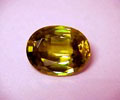
Hyacinth - symbolism of the stone
Hyacinth is a talisman. The predominant color of the stone is red, but it often forms a complex with shades of brown and yellow. Hyacinth is a stone of Moon, Saturn and Uranus. Hyacinth as translucent material has affinity with some treasures. Thus, in the East, it is considered a "brother" of the diamond. At present, hyacinth is often called noble zircon. The extraordinary brilliance of hyacinth is lost when the stone is exposed to fire or curiously when storm is approaching.
It is believed that this mineral was named after the hyacinth flower, the Greeks had a legend about a beautiful young man - the son of the King of Sparta Ebala and very dear to Apollo, the god of the sun. One day, Apollo threw from the clouds a hard discus. Hyacinth ran to the place where he had to drop the discus and he wanted to prove to his divine friend how he was good at discus throwing. But the wind god Zephir having no scruples for this young hero brought the discus straight to his head, mortally wounding him. Apollo stunned with grief, in memory of Hyacinth made to grow a fragrant flower from his blood.
Hyacinth, as many gemstones, has its magical properties.
So, this stone ensures its owner a better mental activity and a natural boost in the development of the various sciences. In ancient times, blue zircon, as a subspecies of hyacinth, was regarded as a guardian of travelers, because, according to legend, it was able to protect them from snake bites and wild animal attacks. In addition to these properties hyacinth also has the ability to improve memory and increase the level of intelligence. Hyacinth is also considered to be a stone of sadness and pain. Hyacinth has been attributed to have a soothing effect: it was thought that it could remove the anxiety, give hope, and was worn during the depression. But despite all this, hyacinth brings loneliness and unhappiness in love. In Russia in the 19th and 20th centuries it was considered to be a stone of merchants and artists.








